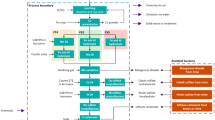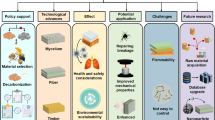Abstract
Contrary to other wind turbine components such as steel towers, concrete foundations and the high value metals used in generator linings, whose end-of-life is properly described in life cycle assessment (LCA) studies, composite blades have proven to be the sustainability blind spot of wind energy systems. The reason for this is that end-of-life management of composite wind blades is a complex engineering problem which depends on the actual design of the blade, its material composition, the availability of recycling technology, legislation and requisite infrastructure, as well as the economics of the process itself—including the logistics of transportation, dismantling, etc. This paper offers a comprehensive analysis of current and potential decommissioning scenarios for end-of-life composite wind blades. Based on 40, in depth, semi-structured interviews with North American and European wind energy experts and a meta-analysis of 52 LCAs of wind energy this paper argues that over approximately the next 5 years, the wind industry will face a significant challenge: as the focus on sustainability engineering and product stewardship shifts the waste disposal responsibility to original equipment and component manufacturers, wind system LCAs may include—and may increasingly become more important in determining—end-of-life scenarios for composite blade waste. It is still too early to ascertain whether LCA will determine the future of composite wind blade recycling by either promoting or legitimizing a certain scenario over another. Nevertheless, as LCAs becoming increasingly more popular in both wind energy and composite recycling, a likely conclusion is that as more economically viable recycling options become available, LCAs will examine the decommissioning phase of used and damaged blades in more detail.

Similar content being viewed by others
Notes
The interviews for this article were conducted between 2012 and 2014 while the author was working as a doctoral candidate at the department of Environmental Science, Policy and Management at the University of California at Berkeley. The interviewees (engineers by training, LCA experts, renewable energy and recycling company owners, as well as sustainable materials researchers) were contacted via email and a questionnaire was provided to them after they had agreed to participate in the research. The interviews were recorded (upon interviewee’s informed consent) and the data was transcribed. The research was supported by National Science Foundation award NSF #1354545. Unless the interviewees requested otherwise, the data for this article is presented anonymously.
This is true in the US (several interviewees). Simon Joncas (personal communication) reported that the same applies to wind farms in Quebec, Canada.
The company claims that producing only 500 items from each category of its products would require over 3 million pounds of fiberglass per month (personal communication).
In this context, the idea of transitioning to what most experts consider “a second-rate performing alternative” [biocomposites] does not seem viable in the highly competitive nature of wind energy (interview data).
Windflow New Zealand uses laminated wood veneer (Pinus radiata) to produce blades with outstanding stiffness/weight and fatigue properties. Commercially available wood veneers (with commercially available quality controls for density and moisture) laminated with commercially available epoxies result in laminate structures with well characterized fatigue strengths which can be used in independently certified wind turbine blade designs. As of March 2013, Windflow had sold 224 blades (John Arimond and Peter Brooking, personal communication).
According to Dr. Conchur O’Bradiagh, joint managing director of the company, “that business is growing.” Micro wind turbine technology was first commercialized with a Scottish company (Proven Energy), which went into liquidation in late 2011 and was later purchased out of liquidation by the top small turbine company Kingspan (Ireland). Kingspan has relaunched the six-kilowatt machine on the market, and more recently a fifteen-kilowatt machine. (All data on Gaoth Tec Teo’s technology have been drawn from personal communication with Dr. O’Bradiagh).
Comparing data from the World Wind Energy Association (WWEA)—and assuming a 20-year lifespan for a wind turbine’s blades—Vestas researchers have claimed that by 2017 “there will be a significant increase in the decommissioning of wind turbines” [8].
Julie Teuwen, the TU Delft PhD. and thermoplastic blades expert, now works for GBT.
Data from [30], LMWindpower.com, and personal communication with LM personnel. LM had a 47% market share in 2001, 25% in 2008 and 14% in 2011. In 2010, LM expanded its operations in China and India (4 new facilities; expansion of already existing facilities). As of October 2012, LM Wind confirmed plans to construct a blade facility in Brazil.
[15] notes that LM Wind’s insistence on polyester is due to the cost benefits: epoxy is approximately three times more expensive than polyester.
[16].
In Germany, Denmark and India, a wind turbine has to have a valid certification to get a building permission. In The Netherlands and most of the other European countries, as well as in the US, Canada and Australia, investment groups and banks require certification for the turbines—including the blades.
References
AECOM Australia Pty Ltd.: Decommissioning and Rehabilitation Plan. Crookwell 3 Wind Farm Project (2012)
Albers, H., Greiner, S., Seifert, H., Kühne, U.: Recycling of wind turbine rotor blades—fact or fiction? DEWI MAGAZIN. 34, 32–41 (2009)
Andersen, P. D., Borup, M., Krogh, T.: Managing long-term environmental aspects of wind turbines: a prospective case study. I J T P M 7, 339–354 (2007)
Bernasconi, A., Rossin, D., Armanni, C.: Analysis of the effect of mechanical recycling upon tensile strength of a short glass fibre reinforced polyamide 6,6. Eng. Fract. Mech. 74, 627–641 (2007)
Buczynski, B.: Old wind turbines find new life in playground. Earthtechling (2012). http://earthtechling.com/2012/04/wind-turbines-recycled-into-dutch-playground/. Accessed 12 Jul 2016
Cherrington, R., Goodship, V., Meredith, J.O., Wood, B.M., Coles, S.R., Vuillaume, A., Feito-Boirac, A., Spee, F., Kirwan, K.: Producer responsibility: defining the incentive for recycling composite wind turbine blades in Europe. Energ. Policy. 47, 13–21 (2012)
Duflou, J.R., Deng, Y., Van Acker, K., Dewulf, W.: Do fiber-reinforced polymer composites provide environmentally benign alternatives? A life-cycle-assessment-based study. MRS Bull. 37, 374–383 (2012)
Dyer, A.: Innovate10 sustainability seminar vestas recycling project (2010)
European Parliament: Directive 2012/19/EU of the European Parliament and of the Council of 4 July 2012 on waste electrical and electronic equipment (WEEE) (2012). http://eur-lex.europa.eu/eli/dir/2012/19/oj. Accessed 24 Jul 2016
Gardiner, G.: Carbon fiber in the wind. Composites World, 1 July 2007
Goodman, J.H.: Architectonic reuse of wind turbine blades. SOLAR 2010 ASES Conf., May 2010, Phoenix
Gurit Magazine: TechTalk: building wind turbine blades with carbon fibre sparpreg. The Gurit Magazine (2012)
ISO: ISO 15270: 2008 plastics–guidelines for the recovery and recycling of plastics waste (2008). http://www.iso.org/iso/catalogue_detail?csnumber=45089. Accessed 24 Jul 2016
ISO: ISO 17422: 2002 plastics–environmental aspects (2002). https://www.iso.org/obp/ui/#iso:std:iso:17422:ed-1:v1:en. Accessed 24 Jul 2016
Joncas, S.: Thermoplastic composite wind turbine blades. Universite du Quebec, Canada, An integrated design approach, Master in mechanical engineering (2010)
Kabir, MdR, Rooke, B., Dassanayake, G.D.M., Fleck, B.A.: Comparative life cycle energy, emission, and economic analysis of 100 kW nameplate wind power generation. Renew. Energ. 37, 133–141 (2012)
Kanaby, G.: Wind energy supply chain & blades: turbine trends for 2013 (2013). http://www.nacleanenergy.com/articles/15326/wind-energy-supply-chain-blades-turbine-trends-for-2013. Accessed 19 May 2015
Kouparitsas, C.E., Kartalis, C.N., Varelidis, P.C., Papaspyrides, C.D.: Recycling of the fibrous fraction of reinforced thermoset composites. Polym. Compos. 23, 682–689 (2002)
Larsen, K.: Recycling wind turbine blades. Renew. Energy Focus. January/February, 9(7), 70–73 (2009)
Lien, D.: Pipestone wind-turbine blade plant owes $490,000 fine for pollution violations (2011). www.twincities.com, http://www.twincities.com/2011/08/04/pipestone-wind-turbine-blade-plant-owes-490000-fine-for-pollution-violations/. Accessed 20 Jul 2016
LMWindpower.com: http://www.lmwindpower.com/Blades/Technology/Materials.aspx (undated). Accessed 15 May 2014
Martínez, E., Jiménez, E., Blanco, J., Sanz, F.: LCA sensitivity analysis of a multi-megawatt wind turbine. Appl. Energy. 87, 2293–2303 (2010)
McConnell, V.P.: Launching the carbon fibre recycling industry. Reinf. Plast. (2010). doi:10.1016/S0034-3617(10)70063-1
Ortegon, K., Nies, L.F., Sutherland, J.W.: Preparing for end of service life of wind turbines. J. Clean Prod. 39, 191–199 (2013)
Papadakis, N., Ramírez, C., Reynolds, N.: Designing composite wind turbine blades for disposal, recycling or reuse. In: Goodship, V. (ed.) Management, Recycling and Reuse of Waste Composites, pp. 443–457. Woodhead Publishing in Materials, Cambridge (2010)
Pickering, S.J., Kelly, R.M., Kennerley, J.R., Rudd, C.D., Fenwick, N.J.: Fluidized-bed process for the recovery of glass fibres from scrap thermoset composites. Compos. Sci. Technol. 60, 509–523 (2000)
Pickering, S.J.: Thermal methods for recycling waste composites. In: Goodship, V. (ed.) Management, Recycling and Reuse of Waste Composites, pp. 74–99. Woodhead Publishing, Cambridge (2010)
Pimenta, S., Pinho, S.T.: Recycling carbon fibre reinforced polymers for structural applications: technology review and market outlook. Waste Manag. 31, 378–392 (2011)
Skrainka, M.S.: Analysis of the environmental impact on remanufacturing wind turbines. Thesis, Rochester Institute of Technology (2012)
Stewart, R.: Wind turbine blade production-new products keep pace as scale increases. Reinf. Plast. 24 Jan (2012)
Tarverdi, K.: Improving the mechanical recycling and reuse of mixed plastics and polymer composites. In: Goodship, V. (ed.) Management, Recycling and Reuse of Waste Composites, pp. 281–302. Woodhead Publishing in Materials, Cambridge (2010)
Vestas website: Vestas life cycle assessment (LCA). Taking a long term view (2011). Accessed 12 May 2011
Wigh, L.: Old wings still fly. http://www.wigh-design.dk/old-wings-still-fly/ (undated). Accessed 24 Jul 2016
Willett, H.G.: Characterization of composites for wind turbine blades. Reinf. Plast. 56, 34–36 (2012)
Yang, Y., Boom, R., Irion, B., van Heerden, D.-J., Kuiper, P., de Wit, H.: Recycling of composite materials. Chem. Eng. Process. 51, 53–68 (2012)
Acknowledgements
This manuscript is based on research funded under National Science Foundation (NSF) award Number: 1354545
Author information
Authors and Affiliations
Corresponding author
Appendix: Sheet1
Appendix: Sheet1
See Table 5.
Rights and permissions
About this article
Cite this article
Sakellariou, N. Current and potential decommissioning scenarios for end-of-life composite wind blades. Energy Syst 9, 981–1023 (2018). https://doi.org/10.1007/s12667-017-0245-9
Received:
Accepted:
Published:
Issue Date:
DOI: https://doi.org/10.1007/s12667-017-0245-9




